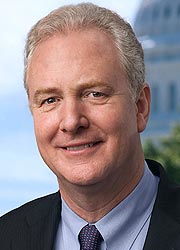He discusses the situation at the US–Mexico border.

US Senator Chris Van Hollen (D-Md)
Frederick, Md (KM) The situation at the US–Mexico border came up during a meeting Wednesday with the Western Maryland Legislation Delegation and US Senator Chris Van Hollen.
He said the recent budget bill enacted by Congress and signed by the President contains money for the Department of Homeland Security. “There’s significant funding in there primarily to intercept fentanyl coming across the border. And it includes more funds to track and inspect passenger vehicles. Passenger vehicles are the primary mode of getting fentanyl into the United States,”: he says.
“It also includes significant $59-million with respect to efforts interdict trans-national fentanyl criminal networks,” he continued.
During the meeting, Delegate William Wivell, who represents Washington and Frederick Counties, had this question. “I think there was a report on the news the other day that the President of Mexico–I don’t know that it was threat—but he basically said if you give us so many millions of dollars we’ll work with you to try to control the inflow of immigrants crossing the border. Is there any hope in working anything out with Mexico as far the ‘Remain in Mexico’ policy being restored,” he asked.
“Remain in Mexico” allowed migrants who wanted to come to the US to remain in Mexico while their cases were being adjudicated in the US.
Senator Van Hollen said he wasn’t familiar with Mexican President’s comments. But he said the Senate had come up with legislation to deal with the border situation. “It was endorsed by the Border Control leaders at the border. But, unfortunately, we were not able to get the votes to proceed on that,”: he said.
On another topic, Van Hollen said the funding bill recently passed by Congress and signed by the President contains $24-million for projects in Western Maryland. “It included everything from a lot of fire station work to some boys and girls clubs funding. Non-profit funding, primarily, but also some municipal funding; for example, water infrastructure and things like that,” he said.
By Kevin McManus